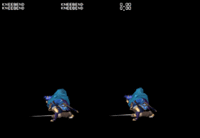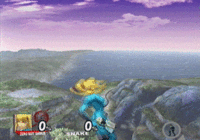Auto-canceling: Difference between revisions
Serpent King (talk | contribs) (Why do we need that) |
Dhiaalhanai (talk | contribs) (added notable examples, more info needed, especially for smash 64) |
||
| Line 6: | Line 6: | ||
Auto-canceling an attack produces no more landing lag than a regular landing from an ordinary [[jump]] (of which the landing lag tends to be around 4-6 frames, a very short amount of time), whereas landing during the middle of an aerial attack almost always results in a significant delay before the character can act (raise a shield, jump, dodge, etc.) again. Most aerial attacks can be auto-cancelled during both the first few frames and the last few frames of the attack's animation; however, some attacks cannot be auto-cancelled at the start, at the end, or even at all. Each individual aerial attack for every character has a specific auto-cancelling window (or lack thereof) that must be memorized and practiced. | Auto-canceling an attack produces no more landing lag than a regular landing from an ordinary [[jump]] (of which the landing lag tends to be around 4-6 frames, a very short amount of time), whereas landing during the middle of an aerial attack almost always results in a significant delay before the character can act (raise a shield, jump, dodge, etc.) again. Most aerial attacks can be auto-cancelled during both the first few frames and the last few frames of the attack's animation; however, some attacks cannot be auto-cancelled at the start, at the end, or even at all. Each individual aerial attack for every character has a specific auto-cancelling window (or lack thereof) that must be memorized and practiced. | ||
Auto-canceling can be very beneficial to players using characters with laggy aerial attacks, as this can reduce the amount of landing lag produced, and create more time for the character to act, potentially avoiding being [[punish]]ed during the move's landing lag. Precise auto-canceling of aerials is also frequently needed for performing followups and [[combo]]s, so as to leave less time for the opponent to react and escape. | Auto-canceling can be very beneficial to players using characters with laggy aerial attacks, as this can reduce the amount of landing lag produced, and create more time for the character to act, potentially avoiding being [[punish]]ed during the move's landing lag. Precise auto-canceling of aerials is also frequently needed for performing followups and [[combo]]s, so as to leave less time for the opponent to react and escape. | ||
In ''Super Smash Bros.'' and ''Super Smash Bros. Melee,'' though auto-cancelling is useful, it generally has no large impact on gameplay, since L-cancelling is effective on its own in reducing landing lag. ''Super Smash Bros. Brawl'' removed L-cancelling. However, aerial attacks in that game generally have more lenient auto-cancel windows to partially compensate. In ''Super Smash Bros. 4,'' L-cancelling continues to be absent, and aerials overall have increased landing lag and auto-cancel much later, hindering aerial approaches and enforcing a heavier reliance on grounded combat. | |||
==Notable Examples== | |||
The following characters' respective moves auto-cancel in a short-hop. | |||
==='''''Melee'''''=== | |||
*{{SSBM|Donkey Kong}}: his up aerial's auto-cancel frames allow it to combo into itself. | |||
*{{SSBM|Marth}}: neutral aerial's large hitbox and long duration make it an effective approach option, especially out of a dash dance. | |||
==='''''Brawl'''''=== | |||
*{{SSBB|Captain Falcon}}: his down aerial meteor smash has good combo ability, and his Knee Smash can be used to approach and KO. | |||
*{{SSBB|Ganondorf}}: approaching with his down aerial meteor smash is known as Thunder-stomping, and it has excellent combo ability as well. | |||
*{{SSBB|Ike}}: his powerful back aerial is useful for both approaching and KOing. | |||
*{{SSBB|Meta Knight}}: all of his aerials auto-cancel in a short-hop. Most notably, his forward aerial's long range and auto-cancel window give it great utility in relieving pressure, approaching, and comboing. | |||
==='''''Smash 4'''''=== | |||
*{{SSB4|Captain Falcon}}: back aerial's range and power make it a useful for approaching, pressuring, starting combos, and KOing. | |||
*{{SSB4|Fox}}: back aerial is good KO move, and neutral aerial can start combos and link into his up smash for another KO option. | |||
*{{SSB4|Ike}}: forward aerial is a good combo move and spacing tool, and back aerial is quick and one of his best KO moves. | |||
*{{SSB4|King Dedede}}: back aerial's range and power make it arguably his best KO move. | |||
*{{SSB4|Luigi}}: all aerials auto-cancel from a short-hop. Forward aerial is good combo move, and back aerial is one of his better KOing options. | |||
*{{SSB4|R.O.B}}: his neutral aerial has a large hitbox, and is effective at approaching, relieving pressure, and starting combos. | |||
*{{SSB4|Sheik}}: forward, neutral, and back aerials auto-cancel in a short-hop. Specifically, forward aerial is one of her best moves, being effective for approaching, pressuring, comboing, and KOing at very high percentages. | |||
==Trivia== | ==Trivia== | ||
Revision as of 14:40, December 11, 2015


Auto-canceling is the act of landing during the beginning or ending frames of an aerial attack, thereby circumventing the landing lag that would have occurred had the character instead landed during the middle of that attack's animation.
Auto-canceling an attack produces no more landing lag than a regular landing from an ordinary jump (of which the landing lag tends to be around 4-6 frames, a very short amount of time), whereas landing during the middle of an aerial attack almost always results in a significant delay before the character can act (raise a shield, jump, dodge, etc.) again. Most aerial attacks can be auto-cancelled during both the first few frames and the last few frames of the attack's animation; however, some attacks cannot be auto-cancelled at the start, at the end, or even at all. Each individual aerial attack for every character has a specific auto-cancelling window (or lack thereof) that must be memorized and practiced.
Auto-canceling can be very beneficial to players using characters with laggy aerial attacks, as this can reduce the amount of landing lag produced, and create more time for the character to act, potentially avoiding being punished during the move's landing lag. Precise auto-canceling of aerials is also frequently needed for performing followups and combos, so as to leave less time for the opponent to react and escape.
In Super Smash Bros. and Super Smash Bros. Melee, though auto-cancelling is useful, it generally has no large impact on gameplay, since L-cancelling is effective on its own in reducing landing lag. Super Smash Bros. Brawl removed L-cancelling. However, aerial attacks in that game generally have more lenient auto-cancel windows to partially compensate. In Super Smash Bros. 4, L-cancelling continues to be absent, and aerials overall have increased landing lag and auto-cancel much later, hindering aerial approaches and enforcing a heavier reliance on grounded combat.
Notable Examples
The following characters' respective moves auto-cancel in a short-hop.
Melee
- Donkey Kong: his up aerial's auto-cancel frames allow it to combo into itself.
- Marth: neutral aerial's large hitbox and long duration make it an effective approach option, especially out of a dash dance.
Brawl
- Captain Falcon: his down aerial meteor smash has good combo ability, and his Knee Smash can be used to approach and KO.
- Ganondorf: approaching with his down aerial meteor smash is known as Thunder-stomping, and it has excellent combo ability as well.
- Ike: his powerful back aerial is useful for both approaching and KOing.
- Meta Knight: all of his aerials auto-cancel in a short-hop. Most notably, his forward aerial's long range and auto-cancel window give it great utility in relieving pressure, approaching, and comboing.
Smash 4
- Captain Falcon: back aerial's range and power make it a useful for approaching, pressuring, starting combos, and KOing.
- Fox: back aerial is good KO move, and neutral aerial can start combos and link into his up smash for another KO option.
- Ike: forward aerial is a good combo move and spacing tool, and back aerial is quick and one of his best KO moves.
- King Dedede: back aerial's range and power make it arguably his best KO move.
- Luigi: all aerials auto-cancel from a short-hop. Forward aerial is good combo move, and back aerial is one of his better KOing options.
- R.O.B: his neutral aerial has a large hitbox, and is effective at approaching, relieving pressure, and starting combos.
- Sheik: forward, neutral, and back aerials auto-cancel in a short-hop. Specifically, forward aerial is one of her best moves, being effective for approaching, pressuring, comboing, and KOing at very high percentages.
Trivia
- The forward airs of Donkey Kong in Melee, and of Donkey Kong and Ganondorf in Brawl, cannot be auto-cancelled during their ending frames. By exploring the code of the games and looking at the underlying properties of the moves, it has been discovered that the developers had intended for auto-cancelling those moves to be possible; however, due to a minor error (the accidental use of the wrong type of timing function), it is not possible to auto-cancel those moves.